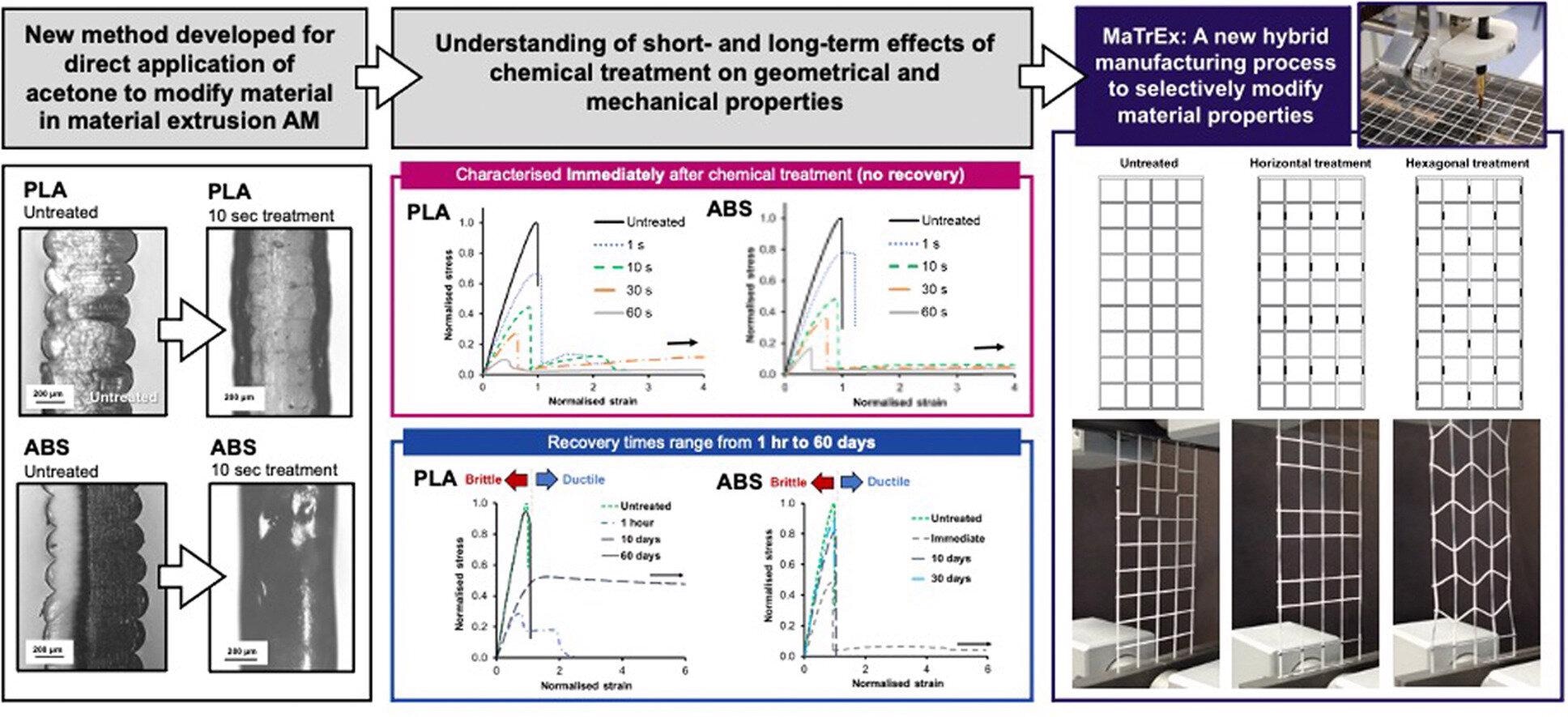Researchers at Loughborough University have used acetone to strengthen polymers in "3D printed" material. They've dubbed their method "Material Treatment Extrusion Additive Manufacturing (MaTrEx-AM)", a hybrid of the popular material extrusion method used in additive manufacturing.
 Image Credit: New hybrid 3D-printing technique will add a fourth dimension to additive manufacturing.(2021) [Online] Phys.org. Available at: https://phys.org/news/2021-10-hybrid-3d-printing-technique-fourth-dimension.html
Image Credit: New hybrid 3D-printing technique will add a fourth dimension to additive manufacturing.(2021) [Online] Phys.org. Available at: https://phys.org/news/2021-10-hybrid-3d-printing-technique-fourth-dimension.html
The process adds material layer-by-layer — there are grooves between the layers, a bit like you'd see if you stacked lots of logs sideways on top of one another, all lined up.
Dr. Andy Gleadall, Senior Lecturer, Loughborough University
This study is the first to demonstrate how mechanical and geometrical properties of polylactide (PLA) and acrylonitrile butadiene styrene (ABS) manufactured by extrusion can be tailored by immersion in acetone. The combination of manufacturing and chemical treatment is a hybrid process that modifies mechanical properties in a time-controlled manner.
This opens up exciting possibilities in additive manufacturing with the introduction of an extra time dimension to "3D printing."
A Quick Primer on Additive Manufacturing (3D Printing)
In additive manufacturing - also termed 3D printing - objects are designed with the help of computer-aided-design (CAD) software. The software digitally slices the object into layers. The software then guides a mechanical nozzle that deposits material layer-by-layer into "printed" 3D objects. In this manner, precise geometrical shapes can be formed.
As the name implies, in additive manufacturing material is added into successive layers to create an object. This is to be contrasted with traditional manufacturing, or subtractive manufacturing, where material is removed through machining, carving or other means to shape an object.
The term "3D printing" was first coined at the Massachusetts Institute of Technology. It referred to the inkjet-based printing process developed there in the 90s. However, the earliest 3D printing equipment can be traced back to Hideo Kodama. He built the first prototype at the Nagoya Municipal Industrial Research Institute in 1980.
ISO/ASTM 52900-2015 defines seven processes in additive manufacturing. Material extrusion is one of the most popular processes.
In additive manufacturing, polymer material is drawn (extruded) through a heated nozzle. Adhesion between the layers of the extruded material is ensured through precise temperature control or the use of chemical bonding agents.
Thermoplastic polymers, such as acrylonitrile butadiene styrene (ABS) and polylactic acid (PLA), used by the Loughborough University team are the most popular materials used in additive manufacturing.
Additive manufacturing enables the manufacture of lighter, more complex objects that are difficult or expensive to manufacture using traditional methods such as milling and machining. Parts previously fabricated from multiple pieces can be manufactured as a single piece, improving strength and durability.
Time-Dependent Materials (4D Printing)
Many materials (such as synthetic polymers) are time-dependent. This means their properties, and thus their functionalities, change significantly with time. This time dependency is inherent to their structure and depends on initial kinetics and thermomechanical boundary conditions.
Their structural properties depend on their thermal properties. Their mechanical properties depend on the mode of loading (static or dynamic) and the type of deformation (shear or bulk) applied.
The researchers at Loughborough University were the first to demonstrate how the mechanical and geometrical properties of polylactide (PLA) and acrylonitrile butadiene styrene (ABS) could be tailored by combining mechanical extrusion and chemical treatment.
Varying the amount of acetone applied allowed them to create objects with novel mechanical properties, for example, enabling them to deform in new ways. Plasticity increased up to 25-fold after chemical treatment.
This ability to mold the time-dependent properties of materials and control their mechanical properties using 3D printing gives this method its "4D printing" capabilities.
3D printed parts are often weak because of the way layers are laid down in sequence, so there are geometric defects between the layers and the bonding of material between layers may not be as good as the pure polymer.
Dr. Andy Gleadall, Senior Lecturer, Loughborough University
Potential applications include 4D lattices for helmet padding and biomedical implants.
The new capabilities are potentially valuable for a huge range of parts and structures, but perhaps most obvious ones would be parts that deform during operation and the way in which they deform needs to be controlled.
Dr. Andy Gleadall, Senior Lecturer, Loughborough University
References and Further Reading
Amirpasha Moetazedian, et al, (2021) MaTrEx AM: A new hybrid additive manufacturing process to selectively control mechanical properties. [Online] Additive Manufacturing. Available at: https://doi.org/10.1016/j.addma.2021.102337
Disclaimer: The views expressed here are those of the author expressed in their private capacity and do not necessarily represent the views of AZoM.com Limited T/A AZoNetwork the owner and operator of this website. This disclaimer forms part of the Terms and conditions of use of this website.